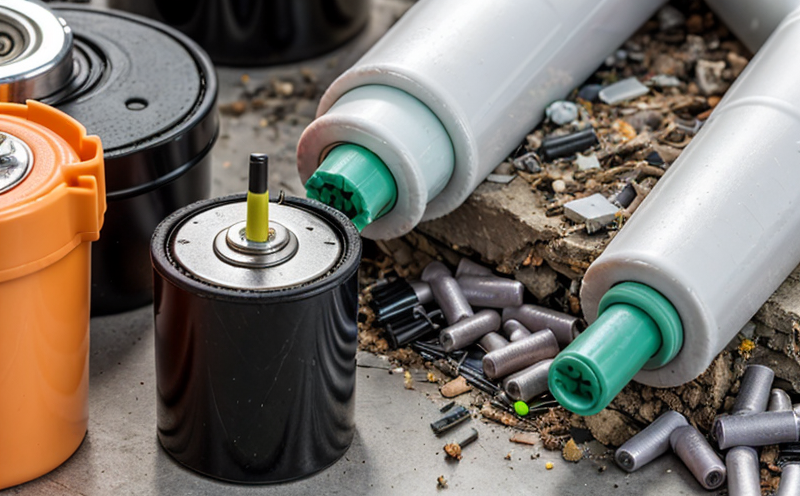ASTM F3147 End-of-Life and Recycling Testing of Rechargeable Batteries
The ASTM F3147 standard is a critical tool in the battery recycling and end-of-life testing sector, providing comprehensive guidelines for the testing and analysis of spent rechargeable batteries. This service ensures compliance with international regulations while offering detailed insights into the chemical composition, capacity retention, and overall performance degradation of these batteries.
Rechargeable batteries are widely used across various sectors including automotive, electronics, telecommunications, and more recently in renewable energy storage systems like solar and wind power applications. As they reach their end-of-life stage, it is essential to assess not only the remaining capacity but also the environmental impact of recycling processes. ASTM F3147 focuses on several key aspects:
- Capacity retention testing
- Cycling performance analysis
- Chemical composition and impurity levels
- Electrolyte decomposition assessment
- Safety evaluation post-recycling treatment
The test parameters are designed to simulate real-world conditions, ensuring that the results accurately reflect how the batteries will perform after being recycled. Specimen preparation involves disassembly of the battery into its component parts, which are then subjected to a series of tests.
Instrumentation used in ASTM F3147 includes advanced electrochemical analyzers capable of measuring voltage changes over time, impedance spectroscopy for evaluating internal resistance, and gas detection equipment to monitor hydrogen evolution during charging cycles. These tools provide precise data points necessary for understanding the battery’s state-of-charge (SOC) and overall health.
The acceptance criteria stipulated by ASTM F3147 are stringent but fair, aiming to strike a balance between environmental protection and efficient recycling processes. Compliance with these standards ensures that recycled materials meet quality specifications suitable for reuse in new products. Additionally, adherence to this standard helps manufacturers comply with regulatory requirements imposed by governments worldwide.
By utilizing ASTM F3147 end-of-life testing services, organizations can gain valuable insights into the lifecycle of their batteries, optimizing resource utilization and reducing waste generation. This approach fosters sustainability practices within industries reliant on rechargeable technologies, contributing to a greener future for all stakeholders involved.
Quality and Reliability Assurance
The ASTM F3147 testing process plays an integral role in maintaining high standards of quality and reliability throughout the battery lifecycle. Through rigorous evaluation techniques, this service ensures that recycled materials meet stringent requirements set forth by international bodies like ISO, EN, IEC, and others.
Quality assurance begins with thorough specimen preparation where each component is cleaned meticulously before undergoing various tests. This meticulous process guarantees accurate results reflecting true performance metrics. Reliability assurance comes into play during the cycling performance analysis phase, ensuring that batteries retain their capacity even after multiple charge-discharge cycles typical of recycling scenarios.
The use of advanced electrochemical analyzers allows for real-time monitoring of critical parameters such as voltage and internal resistance, providing valuable data on battery health. Gas detection equipment further enhances reliability by detecting any signs of hydrogen evolution which could indicate potential safety risks during the recycling process. Compliance with ASTM F3147 not only meets regulatory expectations but also builds trust among customers seeking environmentally responsible solutions.
By integrating these testing protocols into their operations, companies can demonstrate commitment to sustainability and environmental responsibility. This approach ensures that recycled materials are reliable enough for integration back into manufacturing processes without compromising product quality or safety standards.
International Acceptance and Recognition
The ASTM F3147 standard has gained widespread recognition among regulatory bodies, industry associations, and manufacturers globally. Its acceptance ensures that the results obtained from this testing service are universally accepted, facilitating smoother international trade and collaboration.
Regulatory agencies such as the European Union’s REACH (Registration, Evaluation, Authorisation and Restriction of Chemicals) Directive have embraced ASTM F3147 for its comprehensive approach to evaluating battery health post-recycling. Similarly, the United States Environmental Protection Agency (EPA) recommends adherence to this standard when assessing the environmental impact of spent batteries.
Industry associations like the International Battery Association also endorse ASTM F3147, highlighting its role in promoting best practices within the battery recycling sector. Manufacturers benefit from participating in such initiatives as it enhances their reputation and fosters trust with consumers who increasingly demand environmentally friendly products.
The international acceptance of ASTM F3147 extends beyond regulatory compliance into academic research communities where consistent testing methodologies are crucial for advancing scientific knowledge about battery technology. By aligning themselves with this standard, companies position themselves at the forefront of innovation while contributing positively to global sustainability efforts.





